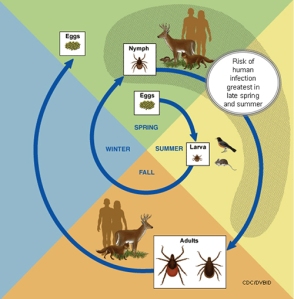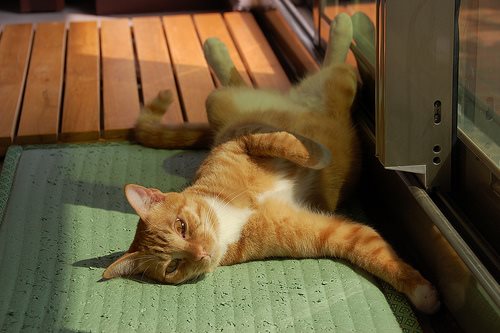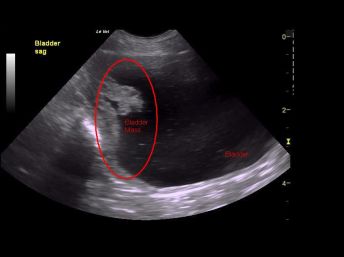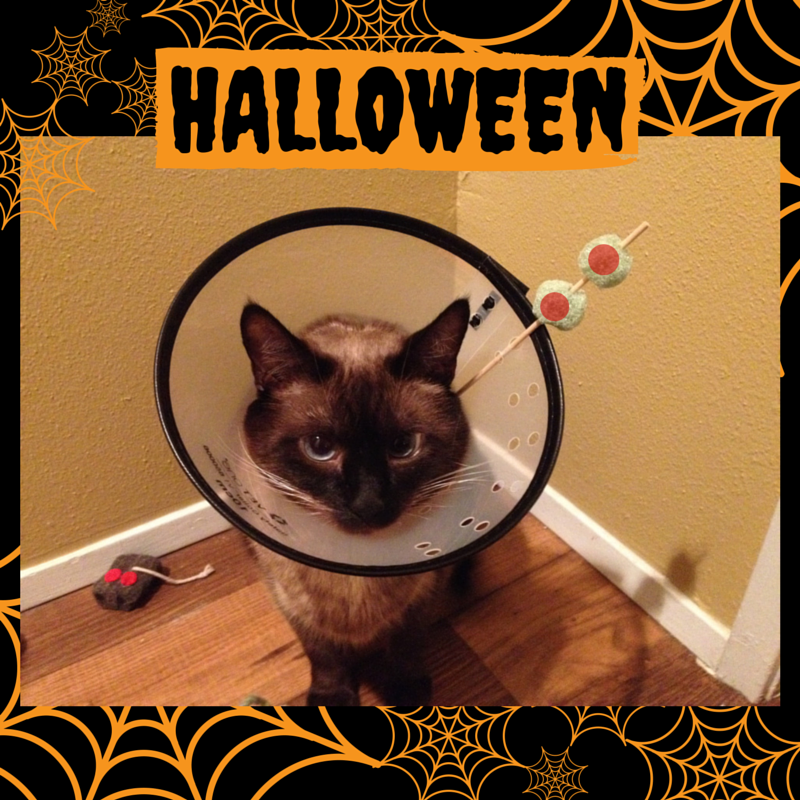Ticks: Arthropod Parasites
Until recently, ticks were rarely seen on our patients at Oswego Veterinary Hospital unless they had traveled to tick heavy regions such as the Columbia River gorge, southern Oregon, or Northern California. This year, 2015, we are seeing a significantly higher number of ticks in our patients who haven’t even left Lake Oswego. This increase in tick exposure is thought to be due to the increasingly warmer, drier weather trends.
Ticks are skin parasites that feed on the blood of their hosts. Ticks like motion, warm temperatures from body heat, and the carbon dioxide exhaled by mammals, which is why they are attracted to such hosts as dogs, cats, rodents, rabbits, cattle, small mammals, etc. The bite itself is not usually painful, but the parasite can transmit multiple diseases. It takes several hours for an attached tick to transmit disease, so owners can usually prevent disease transmission to their pets by following a regular schedule to look for and remove ticks.
Most types of ticks require three hosts during a two-year lifespan – each tick stage requires a blood meal before it can reach the next stage. Hard ticks have four life stages: egg, larva, nymph, and adult. Larvae and nymphs must feed before they detach and molt. Adult female ticks can engorge, increasing their weight by more than 100 fold.
During the egg-laying stage, ticks lay eggs in secluded areas with dense vegetation. The eggs hatch within two weeks. Some species of ticks lay 100 eggs at a time, others lay 3,000 to 6,000 per batch. Once the eggs hatch, the ticks are in the larval stage, during which time the larvae move into grass and search for their first blood meal. At this stage, they will attach themselves for several days to their first host, usually a bird or rodent, and then fall onto the ground. The nymph stage begins after the first blood meal is completed. Nymphs remain inactive during winter and start moving again in spring. Nymphs find a host, usually a rodent, pet, or human. Nymphs are generally about the size of a freckle. After this blood meal, ticks fall off the host and move into the adult stage. Throughout the autumn, male and female adults find a host, which is again usually a rodent, pet, or human. The adult female feeds for 8 to 12 days. The female mates while still attached to her host. Both ticks fall off, and the males die. The female remains inactive through the winter and in the spring lays her eggs in a secluded place. If adults cannot find a host animal in the fall, they can survive in leaf litter until the spring.
What are the best ways to deal with these blood-sucking parasites?
Environmental Control
Treating the yard and outdoor kennel area with a tick spray can be an important tool in the arsenal against ticks. During prime tick months in the summer, spraying may be necessary every 1 to 2 weeks.
If ticks are indoors, flea and tick foggers, sprays, or powders can be used. Inside, ticks typically crawl (they don’t jump) up and may be in cracks around windows and doors. A one-foot barrier of insecticide, where the carpeting and wall meet, can help with tick control.
Prevent Ticks from Attaching
There are over 15 products currently marketed for tick control in dogs and cats. Please consult with your veterinarian as to which product might be safest and most effective for your pets based on their health, lifestyle, and number/type of pets in your household. For pets already on a flea/heartworm product, most tick products are safe to give as long as they are different types of insecticides. Two different tick products should never be used at the same time. Some of the products we carry either in the clinic or on our online store are summarized here:
TOPICAL TICK TREATMENTS –
- Frontline (fipronil) is a liquid applied to the skin between a dog’s shoulders that discourages ticks from staying or implanting. This product lasts a month, also kills fleas and comes in dog and cat doses.
- Revolution (selamectin) is labeled for one kind of tick.
- (Advantix works great for dogs but can be fatal to cats, so should not be used in any household that has cats, or on dogs that may be around cats. For this reason, we do not carry it or recommend using)
COLLARS –
- Preventic collar (Amitraz)– DOGS ONLY over 12 weeks of age. Provides up to 90 days of protection against all types of ticks (not fleas). It is water resistant but should be removed for bathing. Reaches maximum effect in less than 24 hours.
- Seresto collar (Imidacloprid and Flumethrin) – DOGS AND CATS. Provides up to 8 months of tick and flea protection. Does not need to be removed for bathing but more than once monthly baths will reduce effectiveness to 5 months. Reaches maximum effect in 48 hours.
- Scalibor collar (Deltamethrin) – DOGS ONLY over 12 weeks of age. Provides up to 6 months of tick protection. Also kills fleas and repels flies and mosquitoes. Takes 2-3 weeks to reach maximum effect.
ORAL TICK PRODUCTS –
- Bravecto (Flurolaner) – DOGS ONLY over 6 months of age. Provides up to 90 days of protection against ticks and fleas. Maximum effect for fleas is 8 hours, ticks 48 hours.
- Nexgard (Afoxolaner) – DOGS ONLY over 8 weeks of age. Provides up to 30 days of protection against ticks and fleas. Maximum effect for fleas is 8 hours, ticks 48 hours. (This is not currently available on our online store, but Bravecto is)
Flea combs can be used to help remove ticks. Wash your pet’s bed frequently.
Some people use a topical spray, but don’t realize they should not use more than one insecticide or repellent. Doubling the amount of anti-tick product, or using two at once, may cause toxicity problems. DEET, found in many over-the-counter insecticides, is toxic to pets. Any spray insecticide labeled for use on clothing should not be sprayed directly on pets.
Find and Remove the Ticks
The best way to find ticks on your pet is to run your hands over the whole body. Check for ticks every time your pet comes back from an area you know is inhabited by ticks. Ticks attach most frequently around the pet’s head, ears, neck, and feet, but are by no means restricted to those areas.
The safest way to remove a tick is to use rubbing alcohol and a pair of tweezers. Dab rubbing alcohol on the tick, and then use the tweezers to take hold of the tick as close to the dog’s skin as you can; pull slowly and steadily. Try not to leave the tick’s head embedded in the dog’s skin. Don’t squeeze the tick because it might inject some disease-causing organisms, such as bacteria, viruses, protozoa, or other agents, into the animal during the process. Risk of disease transmission to you, while removing ticks, is low but you should wear gloves if you wish to be perfectly safe. Do not apply hot matches, petroleum jelly, turpentine, nail polish, or just rubbing alcohol alone (the tick must be pulled out after application of alcohol) because these methods do not remove the ticks and they are not safe for your pet.
Once you have removed a live tick, don’t dispose of it until you have killed it. Put the tick in alcohol or insecticide to kill it.
Watch/Test for Infection and Diseases
After you pull a tick off, there will be a local area of inflammation that could look red, crusty, or scabby. The tick’s attachment causes irritation. The site can get infected; if the pet is scratching at it, it is more apt to get infected. A mild antibiotic, such as over-the-counter triple antibiotic ointment can help, but usually is not necessary. The inflammation should go down within a week. If it stays crusty and inflamed longer than a week, it might have become infected and you should call your veterinarian.
Ticks can contract disease from a previous host that can then be transmitted to pets and humans. Ticks can parasitize many different mammal species, birds, and reptiles. Lyme disease and ehrlichiosis are probably the most common diseases transmitted by ticks on the west coast. Ehrilichiosis is a rickettsial disease, and its progression from an acute to a chronic stage can be prevented by early treatment. Babesiosis is a tick borne disease that causes red blood cell destruction and anemia in cats. Rocky Mountain spotted fever is the most prevalent rickettsial disease in humans.
Since ticks are just recently becoming more prevalent in the Portland area, we do not yet know the incidence of disease they may carry. For this reason, if you find a tick on your pet we are now recommending that you schedule an appointment to test your pet for Lyme disease and ehrichiosis 2 months later so that if your pet does have this disease, we can institute treatment before they become symptomatic.
While ticks can transmit diseases, they are usually nothing more than a nuisance. The best approach is to prevent them from embedding, and once embedded, to remove them quickly. As long as you stay on top of the situation, your pets should cruise right through the tick season with no problems.
Adapted from Veterinary Partner article, Authored by: Becky Lundgren, DVM
45.420675
-122.670650













